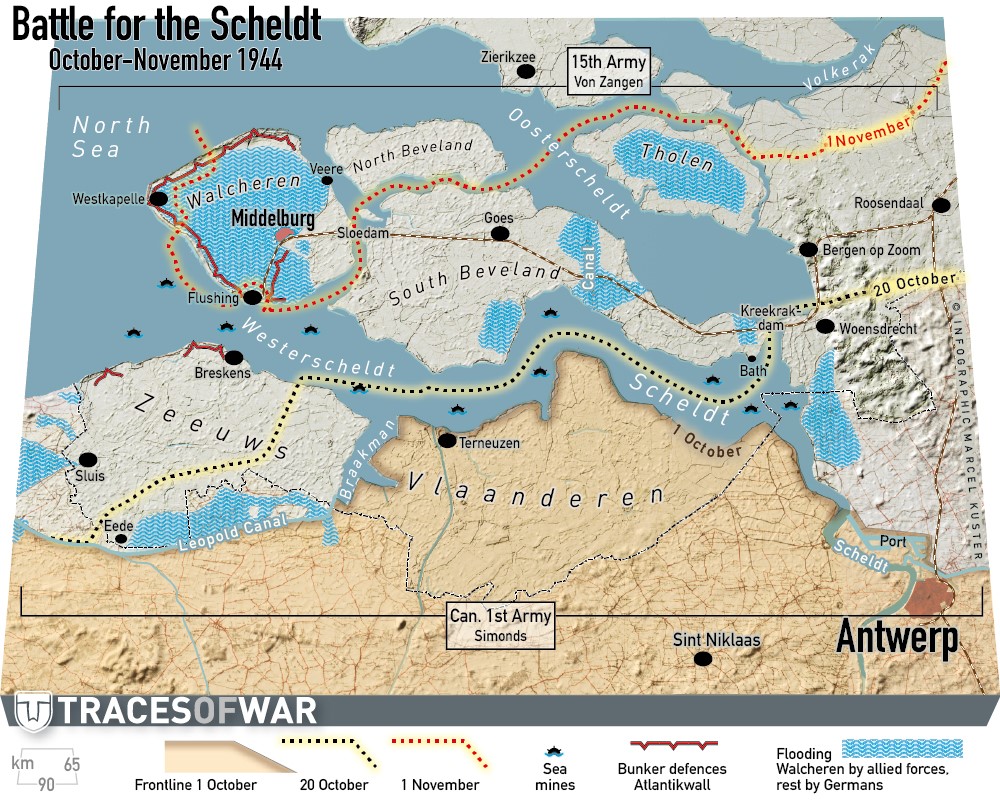Division Headquarters Toorenvliedt Stützpunkt Brünhild
Around the summer of 1942, the Toorenvliedt estate was requisitioned by the German army, which established the headquarters of the Atlantic Wall on Walcheren and both Bevelanden here. The shelter of the park, the location on an arterial road and the proximity of 'Huize Toorenvliedt', villa 'Vijvervreugd' and castle 'Ter Hooge' made Toorenvliedt a suitable location for this important German staff.
Toorenvliedt was referred to as Stützpunkt 'Brünhild'. In 1944 about 9,000 soldiers were brought in from Toorenvliedt. In addition to Commander General-Lieutenant Wilhelm Daser, the staff consisted of 13 officers, 35 non-commissioned officers and 131 enlisted men. The adjacent 'Vijvervreugd' housed the logistics units of the staff, including the field kitchen. Castle 'Ter Hooge' was furnished as an officer's mess and served as the residence of the division commander. Radio - telex and telephone connections were maintained from this communication bunker on Walcheren and higher staffs in Belgium and Northern France. The message traffic from this bunker was partly encrypted via the legendary 'Enigma' coding device.
As the nerve center of the Atlantic Wall, Toorenvliedt was of great strategic importance. In the summer of 1942, the construction of the first thin-walled bunkers began. At the beginning of 1944, the increasing Allied air superiority made it necessary to house the staff in bombproof bunkers. This concerned three command bunkers, a communication bunker and three residential bunkers. Construction did not always go smoothly. A staff bunker subsided in one week to such an extent that the Middelburg fire brigade had to pump out the groundwater. A number of bunkers were camouflaged as a peaceful farmhouse with a gabled roof and painted windows.
Most of the bunkers were used as shelter during bombing raids, the staff members chose the comfortable 'Huize Toorenvliedt' over the concrete. However, when the Allies landed in Normandy on 6 June 1944 (D-Day), the highest alert phase also applied to Walcheren.
From that moment on, the staff also stayed in the bunkers continuously. The end of the Toorenvliedt division headquarters was heralded on 3 October 1944 by the bombing of the seawall of Westkapelle. After the bombing of the other sea dikes, the lower Walcheren slowly but surely disappeared under water. The headquarters had to be evacuated on October 17, 1944. The aim of these actions, to eliminate the German defenses in the hinterland and to disrupt the supply, communication and command and control, was achieved.
After a few wanderings, the divisional staff settled on Dam No. 6 – 8 in Middelburg.
Here General Daser signed the capitulation in the afternoon of November 6, 1944, after a few days of fighting. The war on Walcheren was over, but the salt water flooded the island for more than a year. This also had a devastating effect on Toorenvliedt. The Toorenvliedt house was badly battered and the beautiful park was a dead, bare plain.
After the war, the bunkers were hidden from view by ground cover and vegetation.
In 2008, the Bunker Conservation Foundation excavated the communication bunker (bunker 2) in collaboration with the municipality of Middelburg and made it accessible.
The plan is to restore it and open it up for educational activities, including group tours and battlefield tours. The bunker can serve as a reminder of the far-reaching Battle of the Scheldt for Zeeland.
Photo 1: The communication bunker in 'Park Toorenvliedt' (bunker 2).
Photo 2: The bunker number.
The progress of the restoration can be seen in photos 3, 4, and 5.
An information board has been placed at the entrance of the park with, among other things, the following text:
This park has a rich history as a country estate and as a division headquarters of the Germans in World War II. Children can make a treasure hunt along the bunkers from the first bunker at the main entrance. There is also a route app: WWll Heritage. This can be used offline and can be downloaded via WiFi at the museum bunker. The route passes the 11 bunkers from the Second World War and tells you the history of this location.
Steel plates with lines of poetry have been applied to the bunkers in the park as a work of art. The first letter on the plates with lines of poetry by Henri Looymans form a word. They are intended as a treasure hunt for young people and play equipment has been placed between a number of bunkers.
For the European project "World War ll Heritage" the heritage of the Second World War has been brought to the attention in Park Toorenvliedt, making the history interesting for children.
Do you have more information about this location? Inform us!
Source
- Text: Mia van den Berg / Stichting Bunkerbehoud
- Photos: Mia van den Berg
Nearby
Museum
- Stützpunkt Leuchtenburg - Artillery observation bunker Type 143 Flushing - Vlissingen
- Fortress Rammekens - Ritthem
- Keizersbolwerk Vlissingen - Vlissingen
Point of interest
- Toorenvliedt Estate - Middelburg
- Castle Ter Hooge - Middelburg
- Fire apparatus 'The Magirus' - Middelburg
Monument
- Monument Buffalo amphibious vehicle - Middelburg
- Jewish Memorial Middelburg - Middelburg
- Memorial "The Explosion" Middelburg - Middelburg
Cemetery
- Bombardment 17 May 1940 Memorial - Middelburg
- Dutch War Graves Middelburg - Middelburg
- Dutch War Grave Oost-Souburg - Oost-Souburg
Remembrance Stone
- Stumbling Stone Langevielesingel 66 - Middelburg
- Stumbling Stones Park de Griffioen 22 - Middelburg
- Stumbling Stones Park de Griffioen 10 - Middelburg
Fortification
- Bunker 11 Stützpunkt Brünhild 'Park Toorenvliedt' - Middelburg
- Bunker 1 Stützpunkt Brünhild 'Park Toorenvliedt' - Middelburg
- Bunker 4 Stützpunkt Brünhild 'Park Toorenvliedt' - Middelburg





